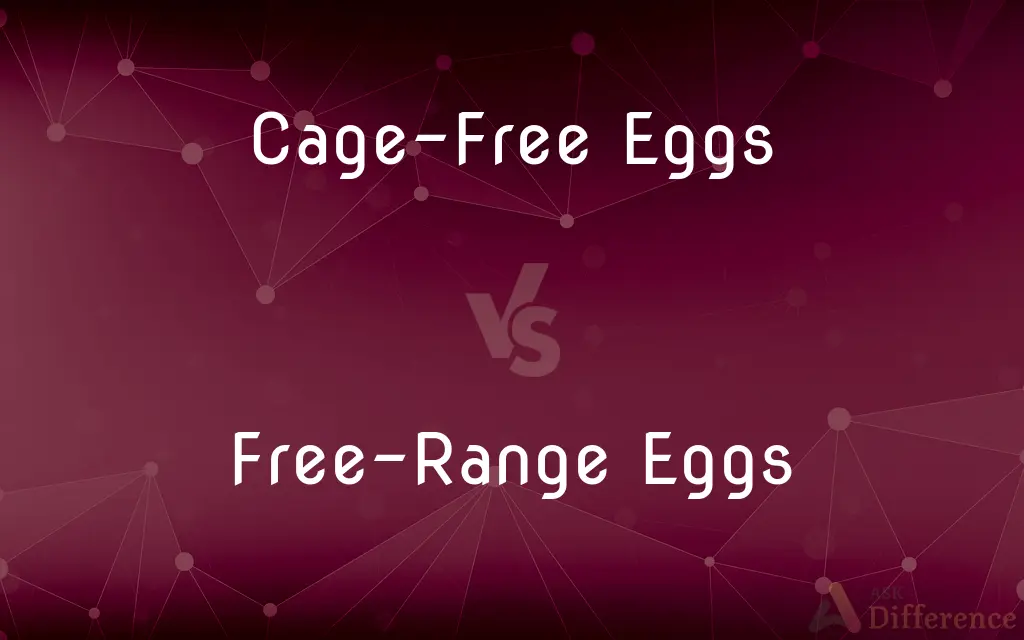Cage-Free Eggs vs. Free-Range Eggs — What's the Difference?
By Tayyaba Rehman & Urooj Arif — Published on February 15, 2024
Cage-Free Eggs come from hens that can roam in a barn but may not have outdoor access. Free-Range Eggs are from hens with access to the outdoors, allowing more natural behaviors.

Difference Between Cage-Free Eggs and Free-Range Eggs
Table of Contents
ADVERTISEMENT
Key Differences
Cage-Free Eggs and Free-Range Eggs represent two approaches to egg farming that aim to improve the welfare of laying hens compared to conventional caged systems. Cage-free systems allow hens to walk, spread their wings, and lay their eggs in nests, all within an enclosed barn without the use of cages. This setup provides better living conditions by giving hens more space and the opportunity to engage in more natural behaviors such as perching and dust-bathing.
Free-Range Eggs take the concept of improved hen welfare a step further by not only allowing hens to roam freely inside a barn but also providing them with access to the outdoors. The outdoor access requirement varies, but it generally means hens can engage in even more natural behaviors in a more natural environment, including foraging and sunbathing, which can contribute to the hens' overall health and welfare.
While both cage-free and free-range systems are designed to address animal welfare concerns, they also have implications for egg quality and cost. Free-range eggs often come at a higher price point due to the additional land and management required to provide outdoor access. Consumers might choose free-range eggs not only for animal welfare reasons but also for perceived quality and taste improvements, although nutritional differences between cage-free and free-range eggs are generally minimal.
The choice between cage-free and free-range eggs often comes down to personal preferences regarding animal welfare, environmental impact, and budget. Both types of eggs provide alternatives to conventionally farmed eggs, where hens live in restrictive cages without the ability to move freely or exhibit natural behaviors.
In summary, while cage-free and free-range eggs both offer higher welfare standards compared to conventional egg farming, the key difference lies in the outdoor access provided to hens laying free-range eggs, potentially leading to better quality of life for the animals and possibly affecting the eggs' nutritional content and consumer's buying decision.
ADVERTISEMENT
Comparison Chart
Living Conditions
No cages, indoor movement
Outdoor access plus indoor freedom
Animal Welfare
Improved over caged
Further improved with outdoor access
Cost
Generally lower than free-range
Higher due to outdoor space requirements
Egg Quality
Similar to conventional, but more ethically produced
Perceived as higher quality due to natural behaviors
Environmental Impact
Lower than caged, but varies
Potentially higher due to land use for outdoor access
Compare with Definitions
Cage-Free Eggs
Allows hens to engage in natural behaviors.
Cage-free hens can perch and lay eggs in nests.
Free-Range Eggs
Eggs from hens with access to the outdoors.
Free-range eggs come from hens that can forage outside.
Cage-Free Eggs
Eggs from hens that live indoors without cages.
I buy cage-free eggs to support better living conditions for hens.
Free-Range Eggs
Supports sustainable farming practices.
Buying free-range eggs contributes to sustainable agriculture.
Cage-Free Eggs
Typically more affordable than free-range eggs.
Cage-free eggs are a budget-friendly option for ethically produced eggs.
Free-Range Eggs
More expensive due to higher farming costs.
The price of free-range eggs reflects the cost of providing outdoor access.
Cage-Free Eggs
A step towards more ethical egg production.
Choosing cage-free eggs is part of my commitment to animal welfare.
Free-Range Eggs
Promotes the highest standard of hen welfare.
I choose free-range eggs because they ensure hens live more naturally.
Cage-Free Eggs
Widely available in supermarkets.
Most stores now carry cage-free eggs due to consumer demand.
Free-Range Eggs
Often considered to have better taste and quality.
Free-range eggs seem fresher and more flavorful to me.
Common Curiosities
Do all free-range hens go outside?
Not necessarily; access varies, but standards require the option for outdoor roaming.
Can cage-free or free-range eggs be organic?
Yes, if they meet organic farming standards, including organic feed and no antibiotics.
Are free-range eggs more nutritious than cage-free eggs?
Nutritional differences are minimal, though some studies suggest marginal benefits.
Why are free-range eggs more expensive?
Due to the cost of land and management for outdoor access.
Are cage-free systems better for the environment?
The impact varies, but both systems aim to reduce negative environmental effects.
Are all cage-free and free-range eggs antibiotic-free?
Not by default; look for additional labeling for antibiotic-free claims.
Can cage-free and free-range eggs help reduce stress in hens?
Yes, by allowing more natural behaviors, which can reduce stress.
Is it worth paying more for free-range eggs?
Many consumers think so for ethical, environmental, or perceived quality reasons.
How do free-range practices affect hen health?
They can lead to improved health through more natural living conditions.
How can consumers verify egg labels?
Look for certifications from reputable animal welfare organizations.
Do cage-free or free-range eggs taste better?
Taste is subjective; some people report a preference for free-range.
What does "pasture-raised" mean compared to free-range?
Pasture-raised hens have more outdoor space than typical free-range systems.
Do hens produce more eggs in cage-free or free-range environments?
Production can vary; stress reduction might support healthy laying rates.
How do I choose between cage-free and free-range eggs?
Consider your priorities regarding animal welfare, environmental impact, nutrition, and cost.
Are there laws regulating free-range egg production?
Regulations exist but can vary significantly by region and certification standard.
Share Your Discovery

Previous Comparison
Insanity vs. P90X
Next Comparison
2D Movies vs. 3D MoviesAuthor Spotlight
Written by
Tayyaba RehmanTayyaba Rehman is a distinguished writer, currently serving as a primary contributor to askdifference.com. As a researcher in semantics and etymology, Tayyaba's passion for the complexity of languages and their distinctions has found a perfect home on the platform. Tayyaba delves into the intricacies of language, distinguishing between commonly confused words and phrases, thereby providing clarity for readers worldwide.
Co-written by
Urooj ArifUrooj is a skilled content writer at Ask Difference, known for her exceptional ability to simplify complex topics into engaging and informative content. With a passion for research and a flair for clear, concise writing, she consistently delivers articles that resonate with our diverse audience.
















































